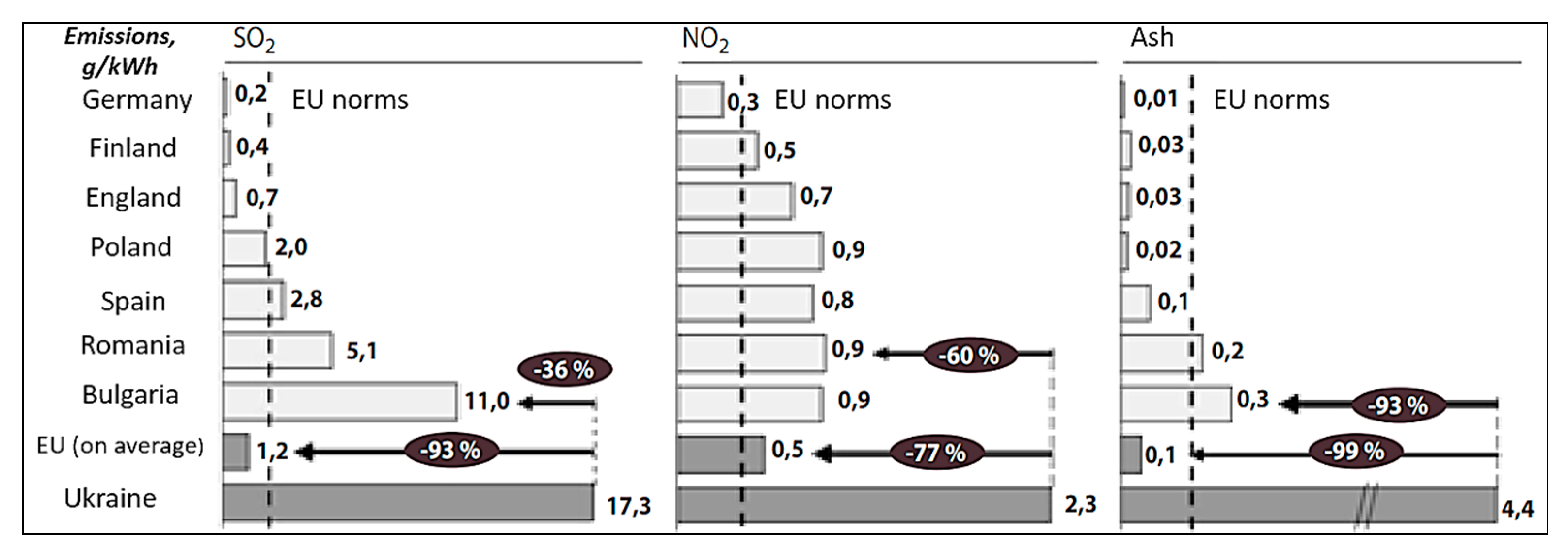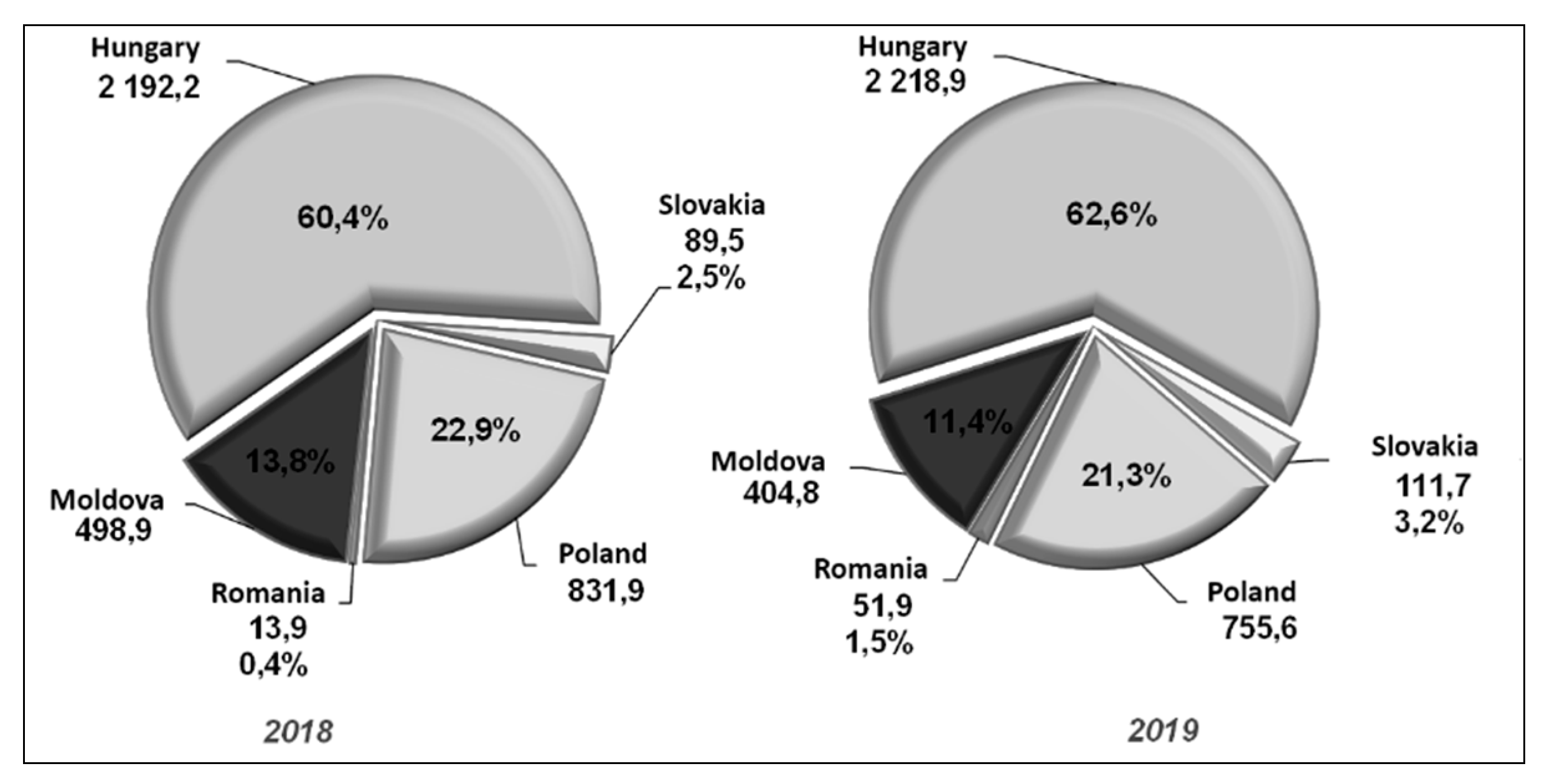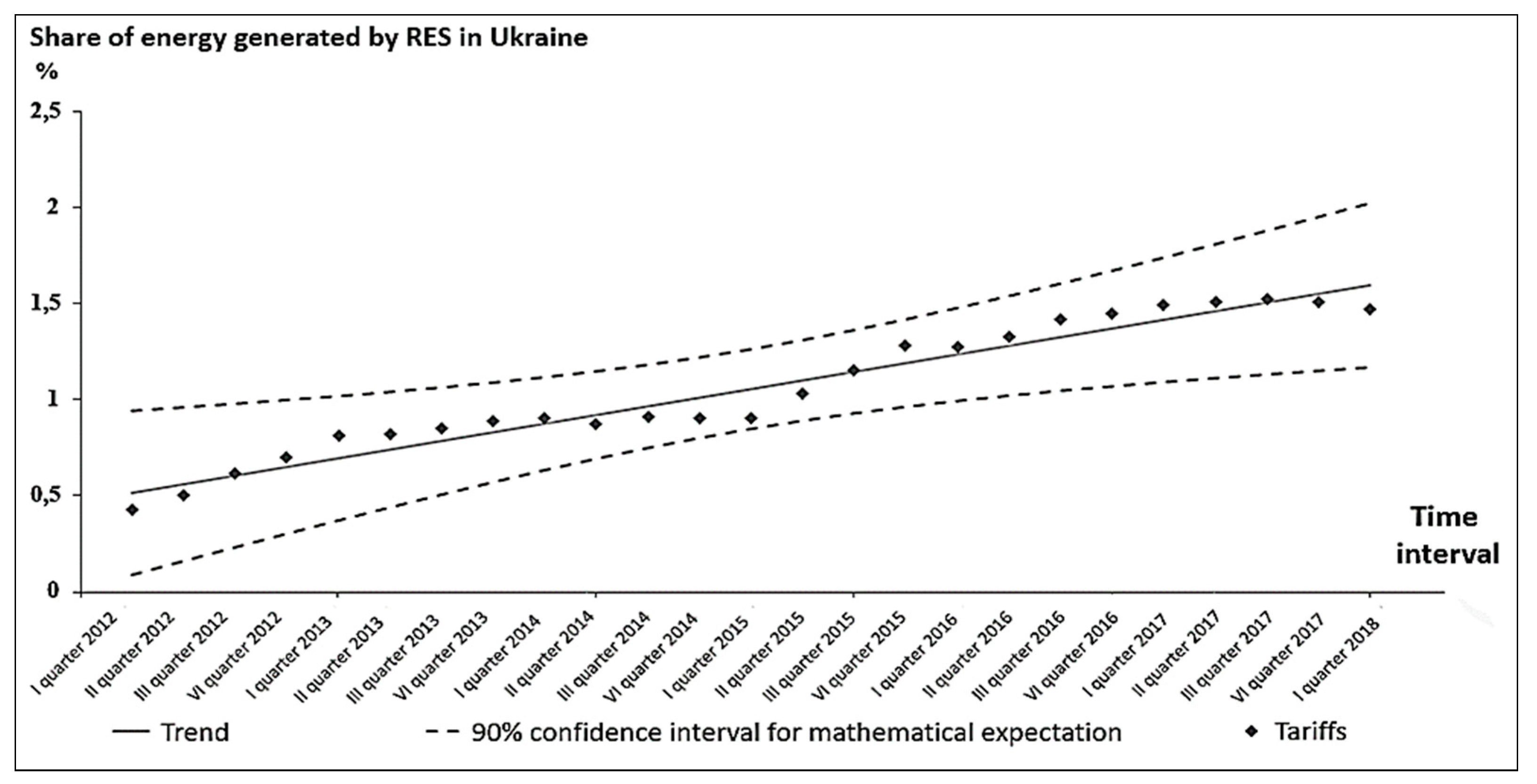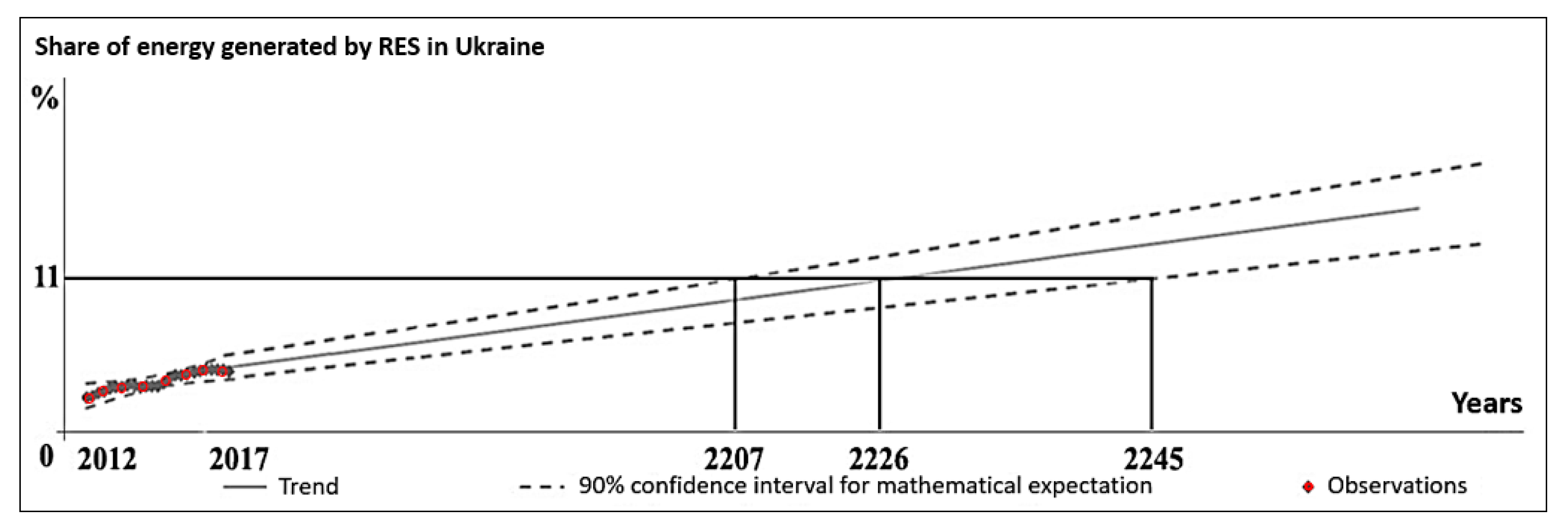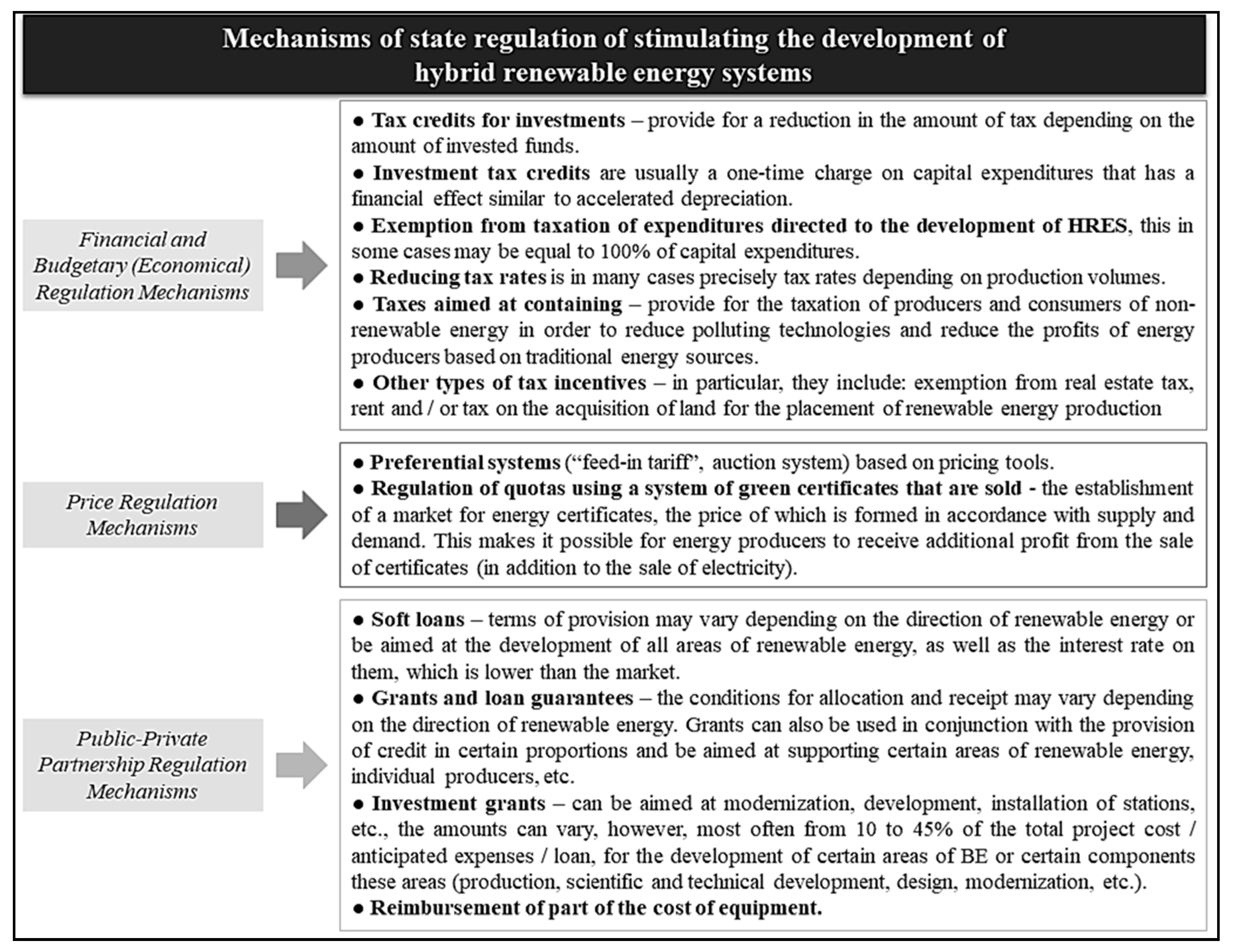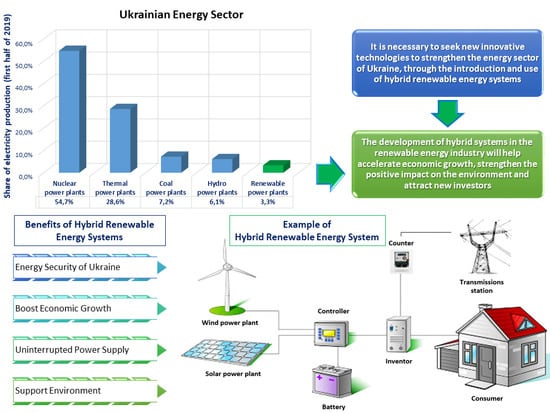1. Introduction
In the present world, the development of the energy sector is a factor that largely determines the vector of the economic development of the country. The Ukrainian economy is one of the most energy-intensive in Europe. Considering the current trend of rising energy prices, there is an increase in demand for steel energy-saving solutions in all sectors of the economy.
The energy intensity of Ukraine’s Gross Domestic Product (GDP) is several times higher than in the developed countries of Europe. In 2017, it was 0.27 tonnes of oil equivalent (toe) for
$1000 of GDP [
1] in comparison with Italy, Germany, France, Poland, Slovakia, and the Czech Republic, where the indicator ranged from 0.08 to 0.13. Therefore, the introduction of renewable energy-saving technologies is necessary to strengthen national energy security and is one of the priority tasks of state policy, as well as an important condition for the sustainable development of the country.
Ukraine uses various sources of energy for its own needs, such as oil, coal, gas, nuclear, hydropower, wind, solar energy, etc. Most of the generating assets and energy supply networks (thermal, nuclear, and hydropower) are worn out and inefficient. Most thermal power plants have exceeded the physical wear limit, and these require thorough modernization or replacement, as well as most nuclear power plants [
2].
Consumption of Russian gas in the past led to severe political crises and created strong economic and political dependence. On 1 October 2019, a resonant event happened [
3]: for the first time since 2016, electricity was imported from Russia. This action only increases geopolitical pressure on the Ukrainian government.
Lack of domestic energy resources and dependence on energy imports are the main threat to the national security of any country [
4,
5]. That is why the highest priority of the Ukrainian Government is to provide affordable and reliable energy sources to its nation.
Nowadays, the issue mentioned above poses Ukraine with new economic and technological problems to become a significant player in the energy market of Europe [
6]. However, at the same time, the energy sector of Ukraine opens up new opportunities for the search and implementation of innovative developments in the areas of extraction, processing of fossil fuels, production, transformation, supply and consumption of energy; these lead to the need of formulating a new energy policy of the state.
Emissions from the burning and extraction of fossil fuels, the lack of a waste management system and an increase in anthropogenic CO
2 emissions harm the environment and climate-changing. Global warming is changing the climate of our planet, and in some regions, natural disasters are beginning to appear that have not previously passed. Humanity does not have much time to reduce greenhouse gas emissions and restore the energy balance of the planet. Therefore, in the coming years, it is necessary to revise the entire energy policy radically. All must move away from the burning of oil, gas, and coal and switch to more environmentally friendly energy sources, the use of which does not upset the overall energy balance [
7].
These eco-friendly energy sources are named as renewable energy. Renewable energy is the kind of energy that can be used indefinitely, and the source of this energy will never run out within the limits of human existence. These sources include the energy from natural resources—wind, water, sun, and heat. Besides, these renewable energy sources do not harm the environment and also form carbon dioxide or radioactive waste that can pollute the atmosphere, water, and soil. The combination of renewable energy sources reduces the negative impact of greenhouse gases in the Earth’s atmosphere.
The increase in the use of renewable energy resources requires the creation of integrated energy systems for the efficient accumulation and further use of energy, as well as the improvement of technical devices for energy conversion [
8].
The energy sector management is a system of direct government administration that needs to be improved and reformed following new energy trends in the markets (new technologies), namely renewable energy sources and their combinations (hybridizations).
This present study provides the economic and technical characteristics of electricity production in the energy sector of Ukraine. The main elements of the energy system (nuclear, thermal, and hydropower–nonrenewable energy sources) have frequent accidents due to depreciation of energy assets and negative impact on the environment. Consequently, the development and enhancement of the potential of renewable energy sources (wind, solar, small hydro, biogas, and biomass power plants) are proposed, which will become the main elements of energy security of Ukraine. This study has developed a regression model for the development of renewable energy sources, which shows the need for additional solutions to accelerate the growth of clean energy, for example, using hybrid renewable energy systems and their sustainable management in the country.
This paper is structured into the six sections as follows. Following the introduction,
Section 2 reviews the existing energy-related literature to develop hypotheses about the energy security of Ukraine, economic development, environmental impact, and uninterrupted power supply for consumers.
Section 3 explains the utilized methodology of the research.
Section 4 demonstrates the study of the energy sector in Ukraine, a regression model of renewable energy growth results, the prospects for the development of hybrid renewable energy systems, and management of their state regulation mechanisms with interpretations. Afterward, the obtained results of the research presented and discussed in
Section 5. Finally,
Section 6 includes conclusions, recommendations, and further research directions.
2. Literature Review
The need for widespread use of renewable energy sources is determined by the rapid increase in the demand for electric energy, the exhaustion of proven reserves of fossil fuels in the future; crisis state of the environment due to pollution by nitrogen and sulfur oxides, carbon dioxide, dust particles formed from fuel combustion, radioactive, and thermal pollution, etc.
Among the publications of foreign scientists and researchers, there is a tendency to use renewable energy sources as consumers’ power sources that are remote from the general power supply network. The introduction of hybrid power systems is based on wind, solar and hydropower with battery energy storage.
Some of these technologies are already competitive today, and there is every reason to hope that in the future their economic efficiency will grow amid rising prices and more complicated production conditions for traditional (nonrenewable) energy resources.
Thus, the topic of the development of hybrid systems of renewable energy sources in the energy systems of states is very relevant. Nowadays, there is a strong need to create such hybrid energy systems based on renewable energy sources, which would be characterized by the greatest energy efficiency and stability.
2.1. Energy Security of Ukraine
The concept of energy security is multifaceted; it concerns phenomena and processes not only in the energy sector but also in the economy. Energy security is a state of security of a country (region), its citizens, society, state, and economy from the threat of deficit in meeting energy needs with economically affordable fuel and energy resources of acceptable quality under normal conditions and emergency circumstances, as well as from the threat of a violation of the stability of energy supply.
The idea of energy security arose in the process of ensuring political and military control to develop policies and measures to manage risks that affect all elements of energy systems. The authors of the research [
9] show that Ukraine at the legislative level enhances the country’s potential in the field of cyber defense of the energy sector by creating an effective national cybersecurity system.
Information about energy security and the possibility of using energy as potential leverage, as well as "weapons" against the economies of neighboring countries, can be found in Van de Graaf and Colgan [
10]. The authors emphasize the possibility of price manipulation for energy resources such as oil and gas. Therefore, it is worth developing the energy sector and reducing the use of imported energy resources while developing the country’s energy potential.
The development and use of clean energy for the country’s energy security are driven by sustainable investments in the energy sector. In articles [
11,
12,
13], it is noted that a non-volatile country uses clean energy, spends economic resources very efficiently and skillfully, and uses its energy advantages to attract investment in the energy sector.
Renewable energy is one of the most promising sources of energy, and it emits solar radiation. In [
14], it is noted that solar energy is the best option because of its prevalence, significant solar radiation, and a general excess in nature. The wind is an inexhaustible source of energy, the use of which, in comparison with other renewable energy sources, can increase the efficiency of power plants and the country’s energy security.
In the context of the establishment of market relations and taking into account the current state of the energy sector in Ukraine to improve energy security and improve the overall situation in the energy sector, it is advisable to implement an active energy conservation policy and the wide involvement of renewable energy sources in the energy balance.
Hypothesis 1: “The use of renewable energy sources instead of nonrenewable energy sources more likely will increase the level of energy security in Ukraine.”
2.2. Economic Growth
Tangible successes in the development of renewable energy have been achieved in countries where renewable energy has received all-round state economic and legislative support, and large amounts of money have been invested in the development of renewable energy, including the development of new technologies.
The study results of Chen et al. [
15] show that for developing countries to achieve positive economic growth through investment in renewable energy, they need to overcome a certain threshold of renewable energy consumption.
The use of green energy contributes to the stable development of the economy of a progressing state. Economic instruments can improve energy security in Europe, as well as ensuring energy security leads to lower prices and increased national production and increased economic development. The authors of the research [
16] proved that GDP growth correlates positively with the new energy security index, and negatively with the consumer price index.
According to the study of Luqman et al. [
17], renewable energy consumption has an asymmetric positive effect on economic growth. Oil consumption has a negative impact on renewable energy consumption, while it is neutral for nuclear energy consumption.
The empirical evidence is found in the study of Zafar et al. [
18], which suggests that countries should increase investment in renewable energy for sustainable economic and energy growth.
The development of renewable energy is one of the cleanest production routes for the economic development of countries [
19,
20,
21]. Similarly, Hussain et al. in their research [
22] argue that those countries that are more globalized and financially developed have more potential for increasing energy intensity. Moreover, this is due to renewable energy, which makes a significant contribution to increasing energy intensity.
Achieving the sustainable functioning of the energy system of Ukraine can help in the economic growth of the country. However, for this, it is necessary to overcome several barriers in proper planning and support policies in the field of renewable energy.
Hypothesis 2: “The development of renewable energy sources can create opportunities for a country’s economic growth.”
2.3. Environmental Impact
Traditional (nonrenewable) energy based on extractive technologies had reached the level when it became the cause of dependence and the almost colonial state of states engaged in the extraction and sale of raw materials. Presently, civilized democratic states have chosen the path of development of their economy based on the development of renewable energy, that is, energy based on the use of renewable sources and resources. So the use of wind, solar, small hydro, biogas, and biomass power plants are gradually replacing the old power plants in these countries using coal, oil, gas, and enriched uranium. Moreover, this is the only way to solve one of the main problems in the world—environmental degradation and climate change.
The results of the article by Akella et al. [
23] show that there are trends in overall emission reductions in different years, which increase exponentially after the installation of renewable energy systems. The international community has repeatedly raised the issue of the possibility of resolving the environmental situation and containing global climate change processes that are hanging over us. The study of Mazzeo et al. [
24] has presented new multi-criteria solutions in the field of energy, economics, and the environment while optimizing hybrid renewable systems based on a new set of indicators proposed as a standard for future applications when combining diverse renewable plants.
Qiao et al. prove in their research that to suppress CO
2 emissions, the Group of Twenty (G20) countries should stimulate development and consumption from renewable energy sources in developing countries [
25].
The study of Li et al. [
26] argues that the development of hybrid renewable energy systems is an economically competitive solution to reduce greenhouse gas emissions and achieve decarbonization of energy. Hybrid renewable energy systems contribute to the improvement of such factors as maintaining the purity of water, life underwater and on the ground, climate control, as a result, improving health, without which it is impossible to get a quality education and decent work.
Renewable energy is an environmentally friendly inexhaustible source of energy that does not change the functional structure of the Earth. It allows the users to reduce the load on the resource base and reduces the total resource consumption. Therefore, it helps to overcome poverty and responsible consumption.
Hypothesis 3: “Renewable energy sources have an impact on the environmental situation and the containment of global climate change processes.”
2.4. Uninterrupted Power Supply for Consumers
Considering that many renewable energy sources are characterized by instability of the energy potential (variability of wind speed, solar radiation intensity, river flow rate, etc.). The present study does not exclude that it is much more efficient to use them in combined power systems in combination with each other. A correct interpretation of the classification of renewable energy sources is a prerequisite for communication between specialists, the public and authorities. It is necessary for regulation and support from the legislative and control authorities at the regional and global levels of green energy development, as indicated in the study of Rybár et al. [
27].
The study of Hamdy et al. [
28] presents the proposed design of a hybrid solar and wind system with a hydraulic accumulator. The developed model is universal (multifunctional) and can be used to illustrate the volume of energy exchange with the network, as well as to manage demand or predict the use of electricity.
According to Kaldellis [
29], the use of storage systems makes it possible to achieve a smooth curve of generated power. Other conducted studies [
30,
31] suggest the creation of a hybrid system based on wind energy and photovoltaic cells using an appropriate energy storage device.
Renewable energy sources depend on the climatic characteristics of the area, which should be research depending on the region of their installation.
The study of Bhuvaneswari and Balasubramanian [
32] relates the combined hybrid systems based on internal combustion engines. It reveals that diesel engines are recommended to be used as a reserve power source, and the works of French researchers solve the problem of integrating energy systems into a Smart Grid [
33].
In addition, the combination of renewable energy sources can increase the efficiency of the hybrid systems itself due to the synergy of the plants and ensures an uninterrupted power supply for consumers.
Hypothesis 4: “Hybrid renewable energy systems are possibly able to provide uninterrupted power supply to consumers due to the functioning of various renewable energy sources.”
4. Results
The Government of Ukraine is making considerable efforts to develop the renewable energy sector, reducing energy supply, reducing carbon emissions, combating negative climate change, etc.
Presently, the Ukrainian energy sector is in serious condition as a result of almost complete depreciation of the equipment of the main sources of power supply: nuclear 55%, thermal 36%, and hydropower 6% (as of July 1, 2019, the total electricity production in Ukraine is 73 042 million kWh) [
34].
The projects of nuclear power plants (NPP) have a service life limit of 20 years (
Table 1). However, 12 of the 15 operating NPP units operate over the limit in 2020 and currently continue to operate. Each year of over-limit operation of NPP: increases the risks of large-scale disasters, including those of a global nature (for example, “Chernobyl,” “Fukushima”).
As can be seen from
Table 2, all thermal power plants (TPP) of Ukraine, except for one green fill, have exceeded their 40-year design life, that is, they require urgent equipment upgrades.
Considering the issue of heat and power engineering in Ukraine, of the existing 14 TPP—13 have a service life exceeding 40 years, and the absolute majorities have a service life exceeding 50 years. In contrast, the planned service life of the main element of TPP boilers does not exceed 40 years.
TPP are powerful emitters of global greenhouse gas emissions, so presently Ukraine does not adhere to the signed “Kyoto Protocol” (1997) and the “Paris Climate Agreement” (2015). In addition, according to the Ministry of Energy and Environment Protection of Ukraine and Energy Community coal-fired TPP are the most powerful emitters of global greenhouse gas emissions (
Figure 1).
For Ukraine, the amount of major emissions from energy (CO2, NO2, Ash) is several times higher than the norms accepted in the European Union (EU) and significantly higher than the worst emission indicators for poor EU countries (Bulgaria, Romania).
Ukraine has a deficient level of environmental taxation and allows owners of TPP and NPP to receive extra profits due to the deterioration of the environment.
The rate for emissions of 1 ton of CO
2 in Ukraine is the lowest in Europe and amounts to 10 UAH (as of January 01, 2019) [
35] or 0.39 Euros at the National Bank of Ukraine rate of October 13, 2019. For example, rates in Mexico and Poland are 1 Euro per ton of CO
2. At the same time, in Sweden, it is 118 Euros per ton, in Denmark—23 Euros; in the United Kingdom—22 Euros; in Ireland—20 Euros [
36].
From the
Figure 2, it is understood that the situation in HPP is no better because it includes high specific land costs, additional losses for water treatment for consumption by residents of coastal regions, loss of the recreational potential of the Dnipro coast as a result of flowering, destruction of the natural landscape and flooding of large areas of fertile land.
Based on the preceding, it is necessary to change the legislative framework of Ukraine and raise the environmental tax to the European level, as well as upgrade equipment at NPP, TPP, and HPP.
By signing the Paris Climate Agreement, Ukraine committed itself not to exceed 60% of the 1990 emissions in 2030, that is, to reduce emissions by 40% [
37]. One of the elements to achieve this goal is the transition to the production of electricity from renewable sources.
Figure 3 reveals that reducing the cost of renewable energy and rising prices for fossil fuels proves that the Ukrainian economy is moving towards green energy, and the era of nonrenewable sources is coming to an end.
One of the important conditions for the sustainable development of the country’s economy is the transition to energy efficiency and renewable technologies. The main directions of using renewable energy sources (RES) are wind energy, solar energy, river energy, and biomass energy.
Figure 4 indicates the share of electricity production from different energy sources in Ukraine. Among them, more electricity is generated from nonrenewable energy sources.
The main lever for stimulating and developing renewable energy in Ukraine is the introduction of the “feed-in tariff” in 2008 [
38], according to which the state will purchase electricity generated from RES.
As of July 1, 2019, the share of electricity production from renewable energy sources in the total production in Ukraine is only 3.3% (
Figure 5). At that time in Denmark, the share of renewable energy sources in providing electric energy is 74%; in Germany—30%; in Spain—25%; in the USA—23%; in Poland—15% (
www.irena.org).
Green energy is among the priorities for the development of a nonvolatile and economically sound Ukraine. Over the past five years, numerous green projects have been introduced on the territory of Ukraine, in which about 4 billion Euros have been invested.
The development of renewable energy sources contributes to an increase in the supply of electricity for export. However, due to frequent unplanned outages (accidents), losses in power grids and the deterioration of the main nonrenewable energy sources, the share of electricity for export is reduced. In particular, in the first half of 2019, 3 542.8 million kWh of electricity was exported (
$209.57 million) [
39], which was 83.6 million kWh (or 2.3%) less (
Figure 6) than for the corresponding period in 2018 [
40].
That is, on average, electricity was sold at a price:
if we convert the US dollar to UAH at the rate of
$1 = 25.1 UAH (at the rate of the National Bank of Ukraine as of July 1, 2019), we will get the following result:
at the end of 2019, electricity tariffs in Ukraine are:
- -
0.90 UAH (for consumed electricity up to 100 kWh per month);
- -
1.68 UAH (for consumed electricity over 100 kWh per month) [
41].
As a result, Ukraine sells electricity cheaper abroad (1.48 UAH/kWh) than the population of its country (1.68 UAH/kWh).
The development of renewable energy is important for the Ukrainian economy and business, both from the point of view of energy security, and the commissioning of new generating capacity, ensuring environmental friendliness.
The time interval for the existence of the national renewable energy (2012–2018) allows drawing conclusions (
Figure 7) that the huge interim objectives of the “National Energy Efficiency Action Plan Through 2020” [
42] (11% of energy consumption in 2020 due to renewable energy) and “New Energy Strategy of Ukraine till 2035: Security, Energy Efficiency, Competitive Ability” [
43] (25% of energy consumption in 2035 due to renewable energy) can hardly be performed.
It was estimated at what time interval, provided that the existing situation is maintained, the intermediate 2020 goal (11% of energy consumption due to renewable energy) will be achieved. The authors of the present study performed the calculations using regression analysis in Microsoft Office Excel software [
44].
Although the null hypothesis regarding the increase in the share of renewable energy can be rejected by a low significance level (
Table 3), the growth rates themselves (0.045% per year) do not cause much optimism.
According to the State Agency on Energy Efficiency and Energy Saving of Ukraine, the model value of the share of renewable energy in Ukraine (2018) is 1.73%, that is, up to 11% remains 9.27%. After making the calculations, the lower limit of annual growth is 0.041%; the upper limit is 0.049%. Hence, 226 years is the period for which the intermediate goal will be achieved at the lowest possible rate of growth of the energy share or 189 years at the maximum possible growth rate of the share of energy generated by the renewable energy of Ukraine (
Figure 8).
Consequently, there is simply no point in calculating when the final indicators (% of energy consumption due to renewable energy) will be achieved in the documents approved above “National Energy Efficiency Action Plan Through 2020” and “New Energy Strategy of Ukraine till 2035: Security, Energy Efficiency, Competitive Ability”).
To achieve the goals in the “National Energy Efficiency Action Plan Through 2020” and “New Energy Strategy of Ukraine till 2035: Security, Energy Efficiency, Competitive Ability,” it is necessary to master new technologies based on RES.
Any new technologies have advantages and disadvantages. For example, for the installation of RES, the optimal distance to the places of residence of the population is determined by finding various geographical solutions that would allow, without interfering with people to participate in their usual life activities, as well as generate a sufficient amount of clean energy.
Sources of clean energy have the following development barriers in Ukraine:
- -
conflict situation in the east of Ukraine (high risks of project implementation for investors), a financial crisis in the world, potentially affecting power plant operators through credit claims and their investments;
- -
energy intensity of the country and investments in the "reanimating" of nonrenewable energy sources;
- -
imperfection of the legislative mechanism for independent electricity producers;
- -
insufficient number of qualified specialists who could properly provide maintenance of renewable energy equipment;
- -
necessity to purchase and deliver elements for RES from abroad etc.
The RES have periodic, daily, and seasonal cycles in terms of the use of resource potentials. For example, the potential of using one SPP is not enough to achieve a stable and uninterrupted energy supply, since solar insolation reaches its maximum value only in a separate period of the day, and at night the amount of electricity generated generally goes to zero. Alternatively, another example, the wind system alone cannot guarantee a constant load through changing gusts of wind. The independent use of these energy sources as the main power source is not an optimal solution. However, combining two or more RES can partially overcome the limitations inherent in any of them, creating hybrid renewable energy systems (HRES).
There are various combinations of equipment for creating a hybrid power plant large and limited only by the specific application and imagination of the designer. A hybrid power plant consists of three main elements (
Figure 9):
The HRES consists of two or more renewable energy sources, such as wind and solar power plants (
Figure 10), to ensure increased efficiency of power generation by the combined system, as well as to create additional maneuvering capacities with a stable energy supply. In case of a temporary absence of sun and wind, the system will supply consumers with electricity from batteries. In case that the system generates more electric energy than it currently consumes, the control unit will deliver excess electricity to the centralized electric network at the “feed-in tariff.”
In addition, if the service life of each installation is 20 years, with active use, then when combined with other installations, this figure will be 25 years or more.
Based on international experience, the market for hybrid energy systems is developing annually in the United Kingdom, and by 2024 it plans to reach 900 MW cumulative capacity generation. China’s hybrid power systems market is anticipated to grow by over 3% by 2024 [
45]. Increased financing for clean energy sources (for instance, wind-solar, wind-solar-hydro, etc.) helps to reduce CO
2 emissions and supports to overcome the growing demand for electricity. Schemes including “feed-in tariff”, carbon credit, and green bonds have provided an impetus toward the installation of combined power plants, which will further complement the hybrid power solutions market outlook.
The HRES have its characteristics that make them highly efficient and competitive (
Figure 11):
- -
flexibility in the choice of fuel, reliability (the use of excess technologies and/or energy storage), profitability and reduction of harmful emissions;
- -
ability to simultaneously improve the quality and availability of electricity;
- -
functioning of electricity and heat supply systems based on RES using various energy storage systems;
- -
depending on the location, including in the system the maximum number of RES;
- -
providing significantly lower levels of harmful emissions when compared to traditional technologies that use coal, gas, and oil;
- -
achieving sustainable energy supply due to the synergistic effect of the system.
The use of the HRES gives energy independence (an inexhaustible source of energy), profit from the sale at the “feed-in tariff” and energy generation without a negative impact on the environment.
To manage and improve the mechanisms of state regulation of stimulating the development of HRES in Ukraine, state-financial and budgetary regulation of stimulating the development of renewable energy is needed, including through the use of tools differentiated by technology, the evolution of preferential policies and premium payments, the regulation of “feed-in tariff,” etc.
To generalize and systematize various approaches to the classification of key areas of state regulation of stimulating the development of HRES, tools, and mechanisms used to stimulate the development of the studied sphere, in particular state financial and budgetary regulation of stimulating the development of renewable energy sources. The present study offers the results of its vision in accordance with the classification of key means of state regulation of stimulating the development of renewable energy, used globally (
Figure 12). To clarify the terminology, it should be noted that these include taxes, prices, loans, duties, investments, etc.
Only a comprehensive approach to the definition and use of state regulation tools to stimulate the development of hybrid renewable energy systems in Ukraine, balanced and timely management decisions at all levels of government regulation are the key to the rapid development of the renewable energy sector, a significant increase in foreign and domestic investment and increase level of energy independence of the country.
The future of the energy sector will be based on the use of hybrid renewable energy systems, which will reduce the anthropogenic impact of energy on the environment, and will also improve the socio-political and economic situation of Ukraine.
6. Conclusions
The tasks aimed at increasing the economic return on renewable energy sources, increasing profitability and stimulating their production, are the key steps towards the decentralization of energy supply and European integration of Ukraine.
The Ukrainian energy sector is in serious condition as a result of the almost complete depreciation of the equipment of the main sources of power supply: nuclear, thermal, and hydropower. It was concluded that in Ukraine there is a deficient level of environmental taxation, which allows the owners of TPP and NPP to get super-profits due to the deterioration of the environment. The rate for emissions of one ton of CO2 is only 10 UAH (0.39 Euros), whereas at present in the EU countries it is considered that the emission of 1 ton of CO2 causes damage of 20-118 Euros. In accordance with this, it is necessary to change the legislative base of Ukraine and raise the environmental tax to the European level, as well as the new equipment at NPP, TPP, and HPP.
The countries with the largest share of growth in renewable energy have the largest share of the energy supplied to the grid by the citizens themselves. As of July 1, 2019, the share of electricity production from renewable energy sources in the total production in Ukraine was 3.3%. At that time in Denmark, the share of renewable energy sources in providing electric energy was 74%; in Germany—30%; in Spain—25%; in the USA—23%; in Poland—15%.
Ukraine is experiencing an important stage of socio-economic development, in which one of the most important factors is the development of energy efficiency and energy conservation to ensure the country’s energy independence and sustainable development.
Renewable energy has become one of the priorities of man due to the shortage of basic energy resources, the increasing cost of their production, as well as in connection with global environmental problems. If Ukraine reduces its high energy consumption to the European average, a large part of energy imports will become unnecessary, which will lead to the introduction of the latest clean technologies, innovative projects, energy-efficient technologies.
Following the “National Energy Efficiency Action Plan Through 2020” on energy efficiency for the period until 2020, Ukraine, in the energy balance should be 11% of electricity produced from renewable energy sources, and Ukraine’s “New Energy Strategy of Ukraine till 2035: Security, Energy Efficiency, Competitive Ability” was approved 25% for 2035.
According to the developed regression model for the share of renewable energy sources, the study can conclude the slow growth rate of the share of electricity generation from renewable energy sources (0.045% per year). Consequently, it is necessary to seek and introduce new innovative technologies to strengthen the clean energy sector, as well as to achieve the energy goals approved at the legislative level of Ukraine, for example, through the introduction and use of hybrid renewable energy systems.
In the main part of Ukraine, the wind speed in the summer is low, but there is much sun and long daylight hours. In winter, the opposite is true, strong winds and little sunlight. The peak of electric energy generation in solar and wind systems occurs at different times of the year and days. Therefore, hybrid renewable energy systems can produce much more energy, and precisely when it is especially necessary.
Exceptionally renewable energy sources do not provide stable and reliable electricity, so the final solution is to use them in a combined way to form hybrid renewable energy systems.
The development of hybrid renewable energy systems based on renewable energy sources and an increase in its share in the energy balance of a country can build a non-volatile economy and fulfill all international obligations under the Association Agreement with the European Union and the Paris Climate Agreement.
For Ukraine, such mechanisms in the field of hybrid renewable energy systems and mechanisms of state regulation of its development would be useful for application:
- -
improving the mechanism for providing support, taking into account the variability of the volume of expenses and the constant development of technologies;
- -
invariance of obligations to investors on the conditions and rates for the provision of benefits or other types of state preferences throughout the approved legislative period, for the confidence of investors in the feasibility and reliability of investing in the field of renewable energy of Ukraine;
- -
ensuring non-obscurity and coverage of all key stages and features of the process of providing customs privileges, state subsidies for licensing and tariff formation, establishing a green tariff, licensing procedures, to prevent discrimination or selectivity in the process of their provision, ensuring equal conditions for all participants in the renewable energy market.
The development of hybrid renewable energy systems in the renewable energy industry will help accelerate economic growth, strengthen the positive impact on the environment and attract new investors. Furthermore, investments create jobs, strengthen the economy, and pave the way to the carbon-free future of Ukraine.
Renewable energy occupies one of the leading places in attracting investment in the country’s economy, is environmentally friendly and reduces the dependence of Ukrainian communities on coal and gas, and therefore is an important component of the country’s energy security.
The topic of introducing hybrid renewable energy systems in the energy sector of Ukraine will be studied in the future by developing a mathematical model for different climatic zones of the country to use the maximum potential from combinations of renewable energy sources in different regions of Ukraine.
To achieve high technical and economic indicators while using renewable sources, reliable operating parameters of energy equipment and stable energy supply to consumers, it is necessary to create and implement hybrid renewable energy systems in which electricity will be generated and stored, which will become a powerful driver for the country’s energy sector.
